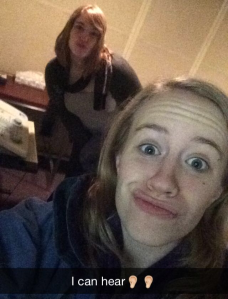“It’s a miracle that curiosity survives formal education.” -Albert Einstein
Some people absorb a lot of information from reading textbooks and listening to lectures. And I’ll admit, I’m capable of learning using those methods.
But hands-on application is my JAM.
 For my audiology class, we’re learning about hearing screenings and audiometry to diagnose hearing loss. The process made sense in lecture, but even better was getting my own hearing tested.
For my audiology class, we’re learning about hearing screenings and audiometry to diagnose hearing loss. The process made sense in lecture, but even better was getting my own hearing tested.
Even better? Performing the hearing test myself.
I took my awesome roommate (S/O to Viv) down to the speech & hearing clinic and set her up in the soundbooth. I gathered her case history, then measured her thresholds of hearing by adjusting frequencies and intensities. I marked down the lowest levels she could hear on an audiogram.
 We weren’t required to do all the diagnostic procedures that a real audiologist does, but it still gave me a good idea of how the process works. Having that hands-on experience solidified my classroom knowledge so much that I wonder why we don’t do more hands-on projects in general.
We weren’t required to do all the diagnostic procedures that a real audiologist does, but it still gave me a good idea of how the process works. Having that hands-on experience solidified my classroom knowledge so much that I wonder why we don’t do more hands-on projects in general.
Perhaps the reason so many college students go to school with no idea of what they want to study is because we don’t give middle and high school students enough opportunities to do job shadows and simulations that would let them test-run a variety of careers.
I came into higher education with a serious interest in speech-language pathology because I’d shadowed a few SLPs for daylong intensives and over a semester in high school. I got to see what they do and talk to them about their perspectives on their work. It didn’t give the total picture, but it gave a good enough idea that I could commit to the major in college.
Whenever possible, teachers should utilize hands-on techniques to teach steps and processes, encouraging visualization of unfamiliar or intangible concepts. Hands-on experiences are irreplaceable. They emphasize problem-solving and application. They go beyond what lectures and readings can’t even begin to cover. They have the potential to shape a young person’s idea of who they are and who they can be.



How true is that Einstein quote? Crazy how the system is now.
LikeLike
Exactly. With everything so test-oriented, it’s hard to believe anyone could still have an ounce of joy or interest in learning.
LikeLike
My high school required a 1 semester mentorship class. You chose a career path and were hooked up with a mentor in the field who you shadowed one afternoon a week for about 3 1/2 months. It was incredibly helpful. The PT program I went to for college also required incoming freshmen to do 25 hours of observation for admission to the program. Such good ideas to not only solidify learning, but to help students know if they REALLY want to do the day to day work involved in a given career!
LikeLike
I love this and I want to show this to all of my high school teachers. I can’t begin even fathom how many peers I’ve talked to who have no idea what they want to pursue; I think if we had more hands-on opportunities/requirements for classes, we could have a better grasp at (at least) a field we want to go in to.
LikeLiked by 1 person
Do it! Or, at the very least, talk about it with them. My school required three “real-world” experiences before graduation, but the requirement was so easy to satisfy that it was hardly meaningful. One community service activity could count, and I don’t know too many people who go to an ivy pull and leave with any more perspective on what they want to do with their lives.
LikeLike
Wouldn’t it be great for high school students to participate in projects like this. Hooray for job shadowing, work experience, internships, work-based learning and apprenticeship! Our students need these experiences so much. I also chose my career (special education) after a month long “Winterim” placement in an afterschool learning program for kids with disabiilities.
LikeLiked by 1 person
Definitely! The real-life application experiences are highly important, it’s a shame there isn’t more emphasis on them.
LikeLike